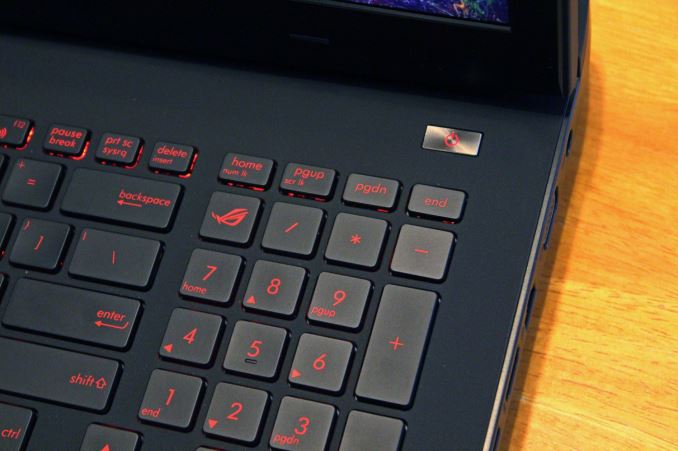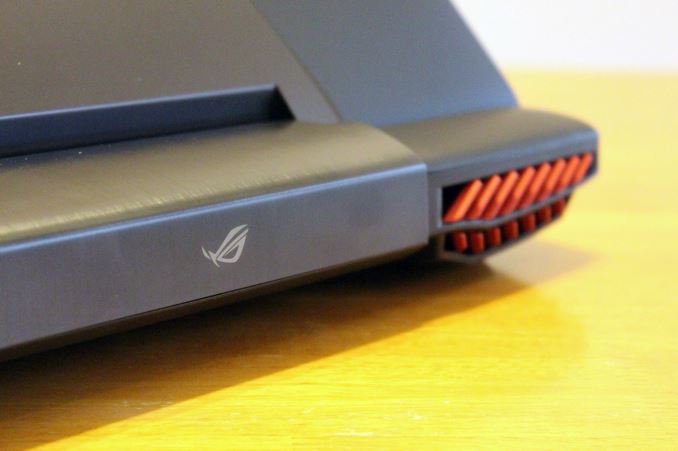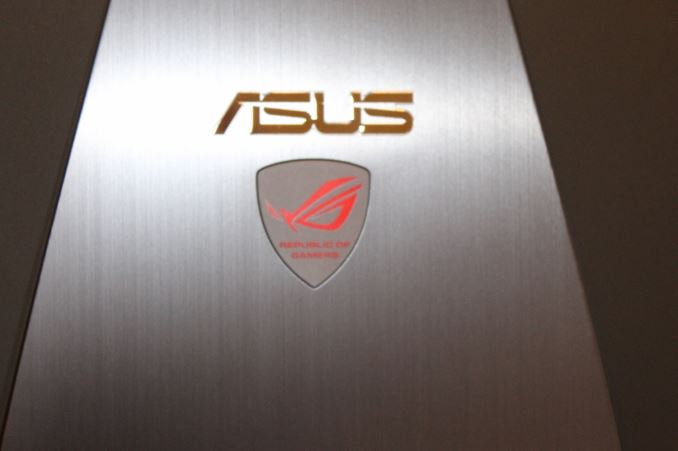The ASUS Republic of Gamers G751 Review: G-SYNC Comes To The Notebook Computer
by Brett Howse on July 29, 2015 8:30 AM ESTFinal Words
Evaluating the ASUS G751 is my first opportunity to use G-SYNC when gaming, and to that end G-SYNC has certainly lived up to its billing. Some of that would also be the very powerful hardware that ASUS has packed into the G751. The GTX 980M continues to impress, and in a device of this size, cooling is not an issue. The other part of the smoothness when gaming though is ASUS’s decision to include a 75 Hz IPS panel. The combination of G-SYNC with this panel makes practically any gaming scenario a silky smooth experience.
The package has some hits and misses. The keyboard and trackpad are quite good, and I’ve already praised the IPS panel which in addition to the 75 Hz refresh rate, has decent color accuracy and contrast. It’s a big step up from the TN panels which can still be found in some gaming notebooks. ASUS has also included plenty of connections including four USB 3.0 ports and a network port. On the miss side is, at least in my opinion, the styling. The G751 seems to have been styled against gaming laptops from a couple of years ago, and hasn’t moved to a sleeker form factor with more premium materials than plastic. Some of that may have been costs though, since ASUS is trying to offer a powerful system at a better price.
The thicker form factor and massive weight of this notebook certainly reduce its portability, and that is further hampered by the poor battery life, which is dragged down by the lack of Optimus support. But for the target audience this is going to likely be the least important criticism. The benefit of no Optimus is G-SYNC support, which on a device like this is certainly the right trade-off.
At this point, all of the hardware inside of the G751 is pretty well known, but that doesn’t take back what it does. The Core i7-4720HQ processor is plenty powerful for most tasks, and while it would have been nice to see ASUS upgrade it to the Broadwell parts, it’s hard to fault them since the quad-core Broadwell upgrade was pretty late in coming. The NVIDIA GTX 980M is the star of the show, as it tends to be, offering some pretty impressive gaming performance in a portable notebook. ASUS has also outfitted the G751 with 24 GB of memory in this model, and they offer an upgrade with 32 GB as well. The included storage is very fast, and it’s great to see them make the move to PCIe based storage. The XP941 is a very quick drive and storage speeds should not ever be an issue. For those that need more flash storage, ASUS does offer a 512 GB version as well as the 256 GB model sampled. The days of the optical drive seem to be numbered, but it’s handy to have a Blu-Ray burner available, and I’ve already used it a few times.
One of the strongest features of the G751 is the cooling system, which seems to pretty easily handle the heat output of the CPU and GPU, but it does this while maintaining a relatively quiet sound levels. It really is quite amazing to be gaming on a system this powerful, and while you can hear the fans, the output and frequency are both low enough to not really bother you. Most gaming laptops are almost always going to need headphones, but the G751 is certainly the quietest gaming notebook that I have encountered.
Overall, I’ve really enjoyed my time with the ASUS G751. It offers plenty of power, a good display, and is among the first laptops to offer the supurb game smoothing capabilities of G-SYNC. It is certainly not inexpensive at $2150 as tested, to $2650 (MSRP) with a faster CPU and double the SSD storage, but it comes in at a good price for a system with this much performance. Online, you can find the as-tested model for $1900 at Amazon, which is a good chunk of change less than the MSRP and really adds to the value of this offering. To me, the one real downside is the styling, but that’s one thing that is really up to the individual. The combination of G-SYNC, a 75 Hz IPS panel, and the GTX 980M make this an incredibly potent gaming notebook.













52 Comments
View All Comments
nathanddrews - Wednesday, July 29, 2015 - link
Does Intel plan on taking advantage of the Adaptive Sync tech anytime soon? I know they use it for other things for power saving (self-refresh, etc.), but it sure seems like a golden opportunity.In the same vein - given that we know (and have known for some time) that the G-Sync module is not required if you have eDP/DP1.2a, when can we expect a shift to tech-agnostic displays? Do we have to wait for DP1.3?
DanNeely - Wednesday, July 29, 2015 - link
I know eDP/DP1.2a provides a similar feature set to G-Sync; but has nVidia actually said anything about adopting it instead of (in addition to?) their current custom hardware implementation?DanNeely - Wednesday, July 29, 2015 - link
I suppose I deserve what I get for commenting before reading the 2nd page of the article; but as long as they're requiring additional qualification work to approve a panel for GSync, there's still plenty of potential to cause trouble for cross GPU support if they wanted to.nathanddrews - Wednesday, July 29, 2015 - link
VESA's Adaptive Sync is a part of eDP and DP 1.2a+. It's there, waiting to be used. G-Sync, FreeSync, and whatever Intel does are just the names for how they utilize it.The only reason NVIDIA pursued a custom module was because no desktop monitors - at the time - included A-Sync. Screens connected via eDP can. As we move forward with newer and newer displays, we're likely to see more and more of them be A-Sync-capable, which means being able to support any variable refresh technology, whatever the marketing label is. Whether or not those displays end up as G-Sync, FreeSync, or some sort of hybrid is up to the manufacturers, I suppose. Just like with G-Sync and FreeSync displays, optimizing the display will still be important.
Ideal situation: connect monitor to computer, GPU drivers load a default profile based upon EDID for frequency range and resolution support, advanced users can tweak (under/overclock/etc.), maybe share firmware, etc. to crowd-source calibration settings. Shipping a monitor back to a manufacturer for an update is ridiculous...
lefty2 - Thursday, July 30, 2015 - link
> The only reason NVIDIA pursued a custom module was because no desktop monitors - at the time - included A-Sync.This is not true. When AMD created FreeSync the DisplayPort 1.2a monitors did not exist either, but instead of creating a propierty solution, they got FreeSync incorperated into the open standard. Nvidia could have done the same thing, but they prefer using propierty standards to lock the customers in.
nathanddrews - Thursday, July 30, 2015 - link
Interesting version of history you've created.DP1.2a display availability lagged behind G-Sync Module display availability by more than a year. If NVIDIA pursued the VESA solution, G-Sync would have been delayed alongside FreeSync. The G-Sync module was absolutely required to get a jump on the market since DP1.2 did not include the Adaptive Sync option. You may not LIKE it, but that's the how it happened.
lefty2 - Thursday, July 30, 2015 - link
DP1.2a display availability also lagged behind FreeSync... AMD just waited had to wait for them to come available (in fact they pushed the standard forward) and Nvidia could have done the same.LoganPowell - Friday, November 27, 2015 - link
ASUS does overall make fantastic computers, but I'd recommend going for the Dell Inspiron i7559-763BLK. Highly approved by many gaming enthusiasts. /Logan from http://www.consumerrunner.com/top-10-best-laptops/Creig - Thursday, July 30, 2015 - link
"additional qualification" = give us money to use the G-sync name.Shadowmaster625 - Wednesday, July 29, 2015 - link
I have a great idea. Let's build Optimus notebooks for five years, and then all the sudden build one without it! Isnt that a great frickin idea? I need to be CEO of Asus.